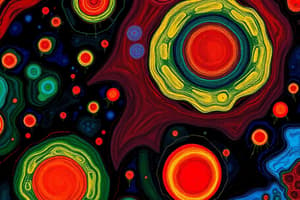Podcast
Questions and Answers
Which organelle increases in both number and size during the senescent phase?
Which organelle increases in both number and size during the senescent phase?
- Lysosomes (correct)
- Mitochondria
- Endoplasmic reticulum
- Golgi apparatus
What happens to heat shock protein expression during the senescent phase?
What happens to heat shock protein expression during the senescent phase?
- It becomes inactive
- It increases
- It decreases (correct)
- It remains unchanged
What do senescent cells secrete that triggers cellular responses?
What do senescent cells secrete that triggers cellular responses?
- Hormones
- Enzymes
- Cytokines and chemokines (correct)
- Antibodies
Which molecule provides the template for creating the repeated DNA sequence in telomerase?
Which molecule provides the template for creating the repeated DNA sequence in telomerase?
What is the main function of telomerase?
What is the main function of telomerase?
Which component of telomerase adds the new DNA segment to the chromosome end?
Which component of telomerase adds the new DNA segment to the chromosome end?
Which cells have high telomerase activity?
Which cells have high telomerase activity?
What is the function of telomerase?
What is the function of telomerase?
Where is telomerase almost absent?
Where is telomerase almost absent?
Flashcards are hidden until you start studying
Study Notes
Senescence and Cellular Changes
- The number and size of lysosomes increase during the senescent phase, indicating cellular aging.
- Heat shock protein expression typically upregulates during the senescent phase, aiding in stress response and protein repair mechanisms.
Senescent Cell Secretion
- Senescent cells secrete a variety of signaling molecules known as the senescence-associated secretory phenotype (SASP), which triggers inflammatory and repair responses in nearby cells.
Telomerase and Its Functions
- Telomerase uses an RNA molecule as a template to synthesize repeated DNA sequences at telomeres.
- The main function of telomerase is to maintain telomere length, thus supporting chromosomal stability and cellular replication.
Telomerase Composition and Activity
- The reverse transcriptase component of telomerase is responsible for adding new DNA segments to the ends of chromosomes.
- Germ cells, stem cells, and certain immune cells exhibit high telomerase activity, allowing them to divide extensively without telomere shortening.
Telomerase Expression Patterns
- Telomerase is almost absent in differentiated somatic cells, limiting their proliferative capacity and contributing to cellular aging.
Studying That Suits You
Use AI to generate personalized quizzes and flashcards to suit your learning preferences.



